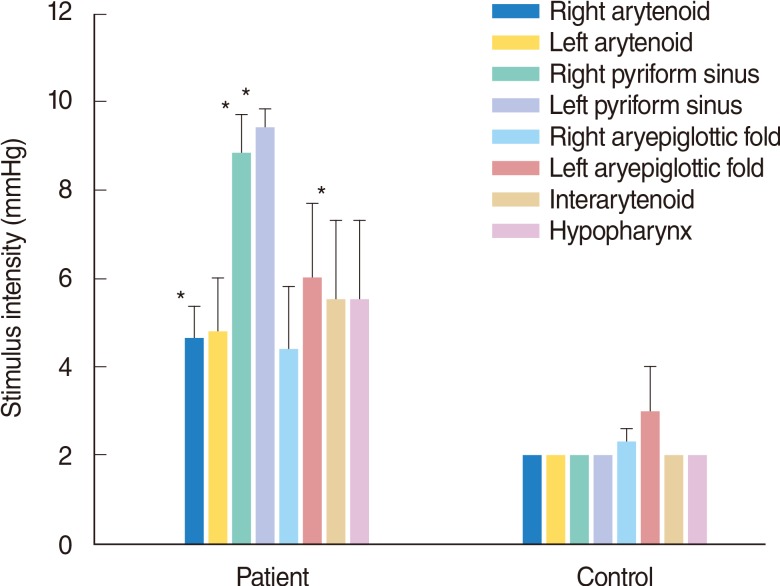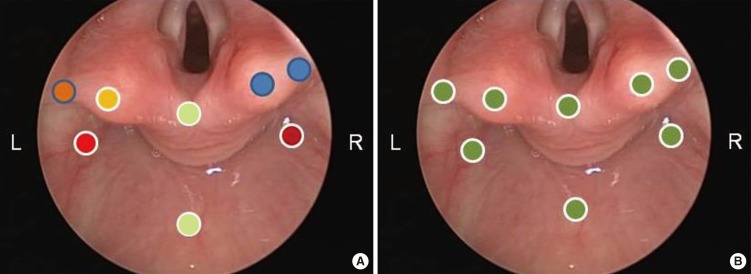1. Aviv JE, Martin JH, Keen MS, Debell M, Blitzer A. Air pulse quantification of supraglottic and pharyngeal sensation: a new technique. Ann Otol Rhinol Laryngol. 1993; 10. 102(10):777–780. PMID:
8215097.

2. Aviv JE, Martin JH, Sacco RL, Zagar D, Diamond B, Keen MS, et al. Supraglottic and pharyngeal sensory abnormalities in stroke patients with dysphagia. Ann Otol Rhinol Laryngol. 1996; 2. 105(2):92–97. PMID:
8659942.

3. Aviv JE, Liu H, Parides M, Kaplan ST, Close LG. Laryngopharyngeal sensory deficits in patients with laryngopharyngeal reflux and dysphagia. Ann Otol Rhinol Laryngol. 2000; 11. 109(11):1000–1006. PMID:
11089989.

4. Aviv JE, Parides M, Fellowes J, Close LG. Endoscopic evaluation of swallowing as an alternative to 24-hour pH monitoring for diagnosis of extraesophageal reflux. Ann Otol Rhinol Laryngol Suppl. 2000; 10. 184:25–27. PMID:
11051427.

5. Setzen M, Cohen MA, Mattucci KF, Perlman PW, Ditkoff MK. Laryngopharyngeal sensory deficits as a predictor of aspiration. Otolaryngol Head Neck Surg. 2001; 6. 124(6):622–624. PMID:
11391251.

6. Suskind DL, Thompson DM, Gulati M, Huddleston P, Liu DC, Baroody FM. Improved infant swallowing after gastroesophageal reflux disease treatment: a function of improved laryngeal sensation? Laryngoscope. 2006; 8. 116(8):1397–1403. PMID:
16885743.

7. Thompson DM. Abnormal sensorimotor integrative function of the larynx in congenital laryngomalacia: a new theory of etiology. Laryngoscope. 2007; 6. 117(6 Pt 2):Suppl 114. 1–33. PMID:
17513991.

8. Thompson DM, Rutter MJ, Rudolph CD, Willging JP, Cotton RT. Altered laryngeal sensation: a potential etiology of apnea of infancy. Ann Otol Rhinol Laryngol. 2005; 4. 114(4):258–263. PMID:
15895779.
9. Amin MR, Harris D, Cassel SG, Grimes E, Heiman-Patterson T. Sensory testing in the assessment of laryngeal sensation in patients with amyotrophic lateral sclerosis. Ann Otol Rhinol Laryngol. 2006; 7. 115(7):528–534. PMID:
16900807.

10. Carr MM, Nguyen A, Poje C, Pizzuto M, Nagy M, Brodsky L. Correlation of findings on direct laryngoscopy and bronchoscopy with presence of extraesophageal reflux disease. Laryngoscope. 2000; 9. 110(9):1560–1562. PMID:
10983962.

11. Carr MM, Nagy ML, Pizzuto MP, Poje CP, Brodsky LS. Correlation of findings at direct laryngoscopy and bronchoscopy with gastroesophageal reflux disease in children: a prospective study. Arch Otolaryngol Head Neck Surg. 2001; 4. 127(4):369–374. PMID:
11296043.
12. Ulualp SO, Toohill RJ, Hoffmann R, Shaker R. Pharyngeal pH monitoring in patients with posterior laryngitis. Otolaryngol Head Neck Surg. 1999; 5. 120(5):672–677. PMID:
10229591.

13. Ulualp SO, Toohill RJ, Shaker R. Pharyngeal acid reflux in patients with single and multiple otolaryngologic disorders. Otolaryngol Head Neck Surg. 1999; 12. 121(6):725–730. PMID:
10580227.

14. Ulualp SO, Toohill RJ. Laryngopharyngeal reflux: state of the art diagnosis and treatment. Otolaryngol Clin North Am. 2000; 8. 33(4):785–802. PMID:
10918661.
15. Belafsky PC, Postma GN, Koufman JA. The validity and reliability of the reflux symptom index (RSI). J Voice. 2002; 6. 16(2):274–277. PMID:
12150380.
16. Aviv JE, Martin JH, Kim T, Sacco RL, Thomson JE, Diamond B, et al. Laryngopharyngeal sensory discrimination testing and the laryngeal adductor reflex. Ann Otol Rhinol Laryngol. 1999; 8. 108(8):725–730. PMID:
10453777.

17. Yoshida Y, Tanaka Y, Hirano M, Nakashima T. Sensory innervation of the pharynx and larynx. Am J Med. 2000; 3. 108(Suppl 4a):51S–61S. PMID:
10718453.

18. Botoman VA, Hanft KL, Breno SM, Vickers D, Astor FC, Caristo IB, et al. Prospective controlled evaluation of pH testing, laryngoscopy and laryngopharyngeal sensory testing (LPST) shows a specific posterior inter-arytenoid neuropathy in proximal GERD (P-GERD). LPST improves laryngoscopy diagnostic yield in PGERD. Am J Gastroenterol. 2002; 9. 97(9 Suppl):S11–S12.

19. Shaker R, Ulualp SO, Kannappan A, Narayannan S, Hofmann C. Identification of laryngo-UES contractile reflex in humans. Gastroenterology. 1999; 116(4 Pt 2):A1081.
20. Kawamura O, Easterling C, Rittmann T, Hofmann C, Shaker R. Optimal stimulus intensity and reliability of air stimulation technique for elicitation of laryngo-upper esophageal sphincter contractile reflex. Ann Otol Rhinol Laryngol. 2005; 3. 114(3):223–228. PMID:
15825573.

21. Kawamura O, Easterling C, Aslam M, Rittmann T, Hofmann C, Shaker R. Laryngo-upper esophageal sphincter contractile reflex in humans deteriorates with age. Gastroenterology. 2004; 7. 127(1):57–64. PMID:
15236172.







 PDF
PDF Citation
Citation Print
Print











 XML Download
XML Download